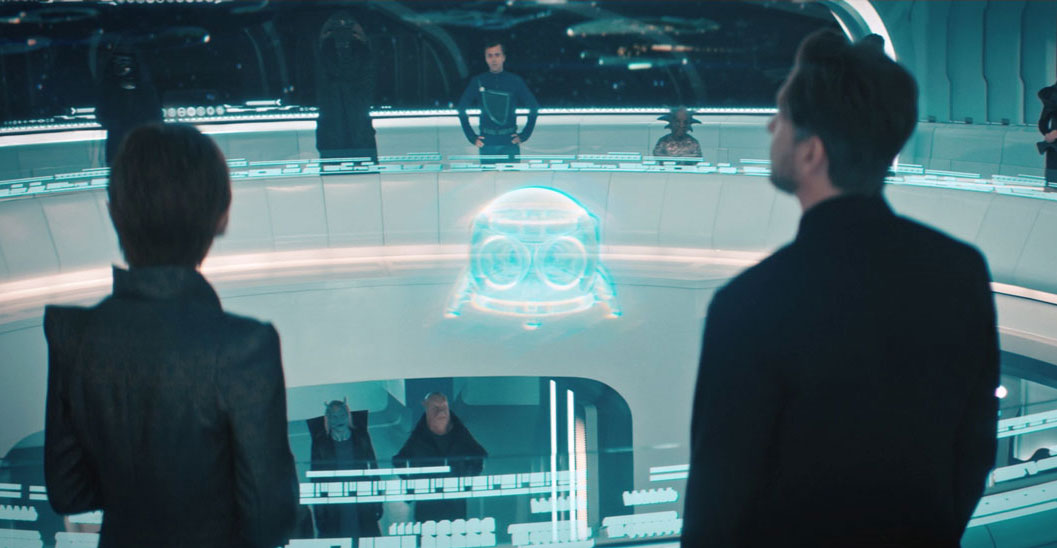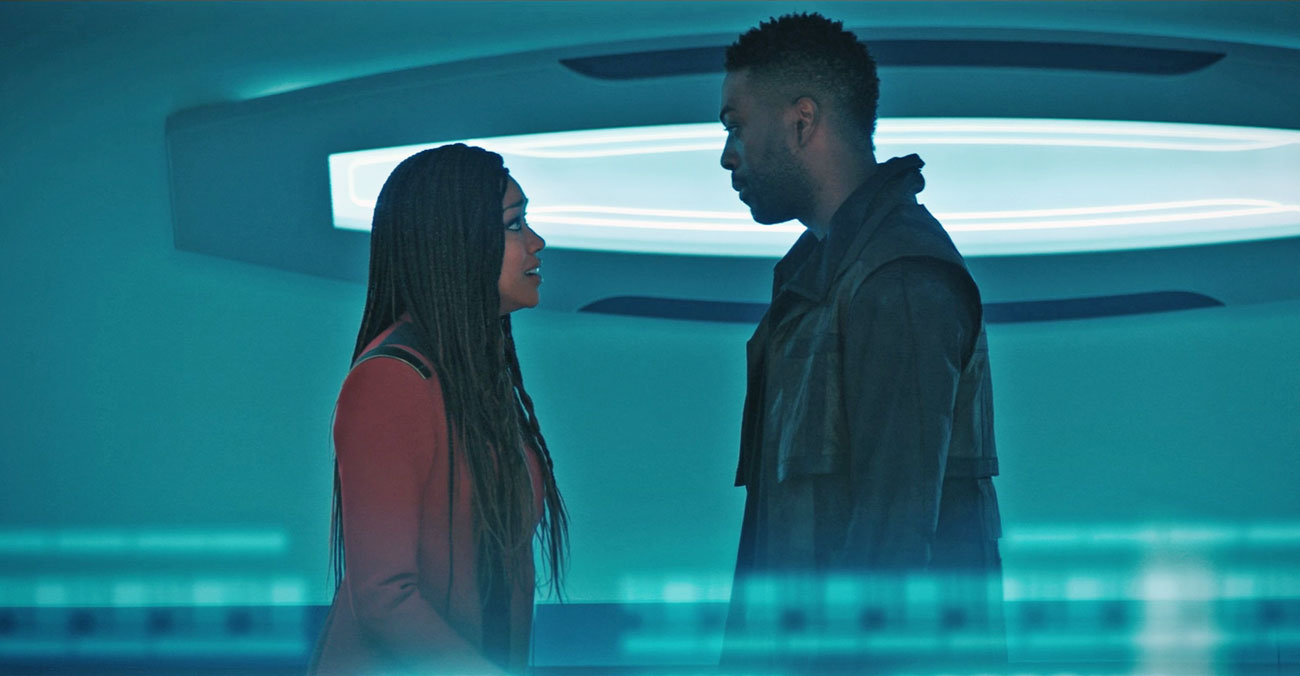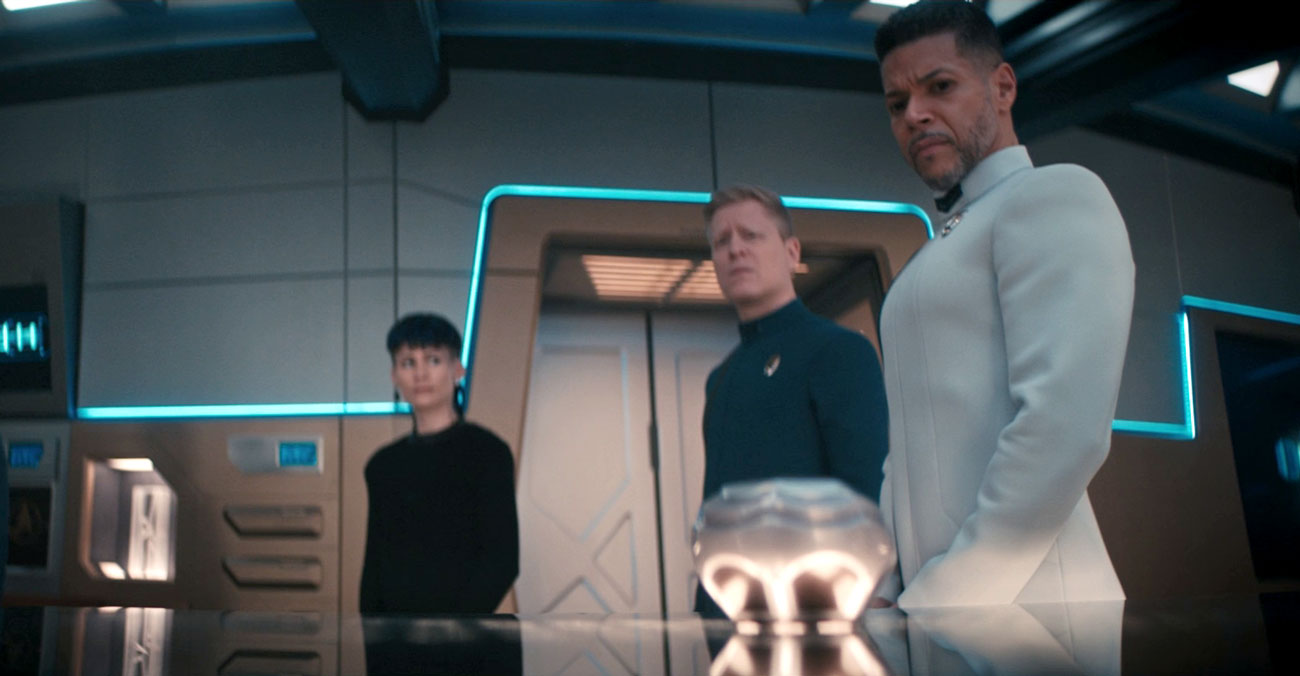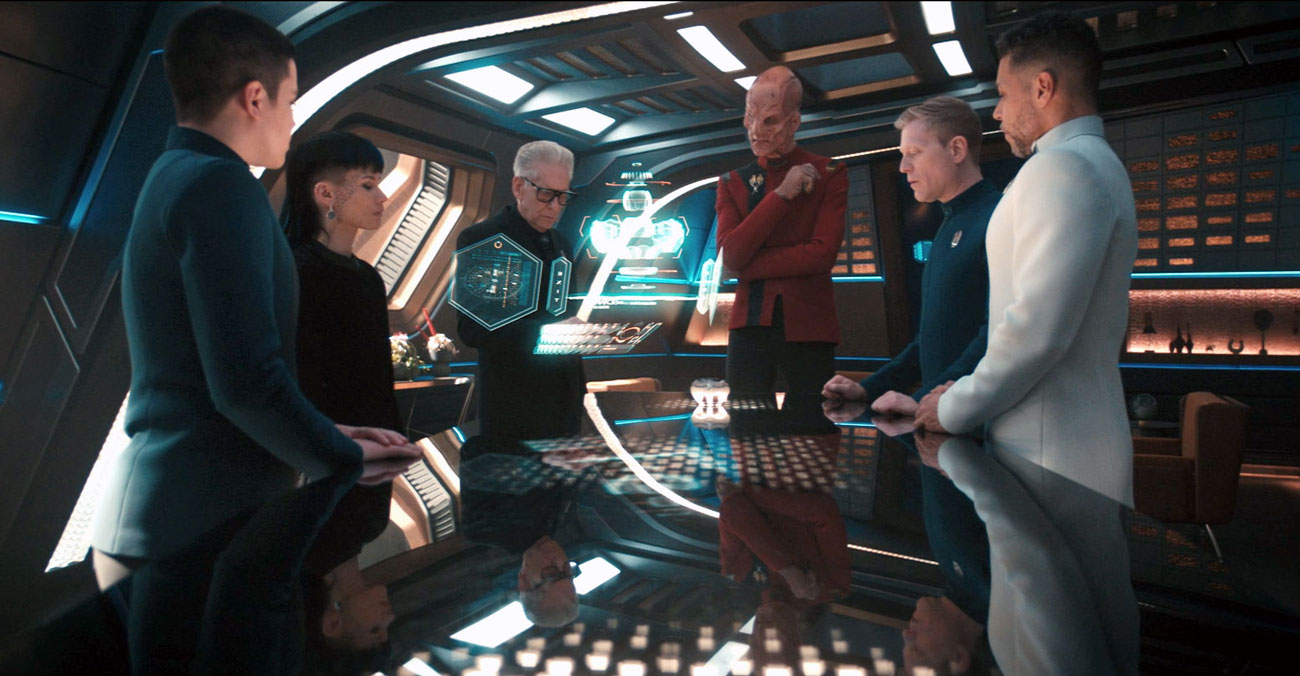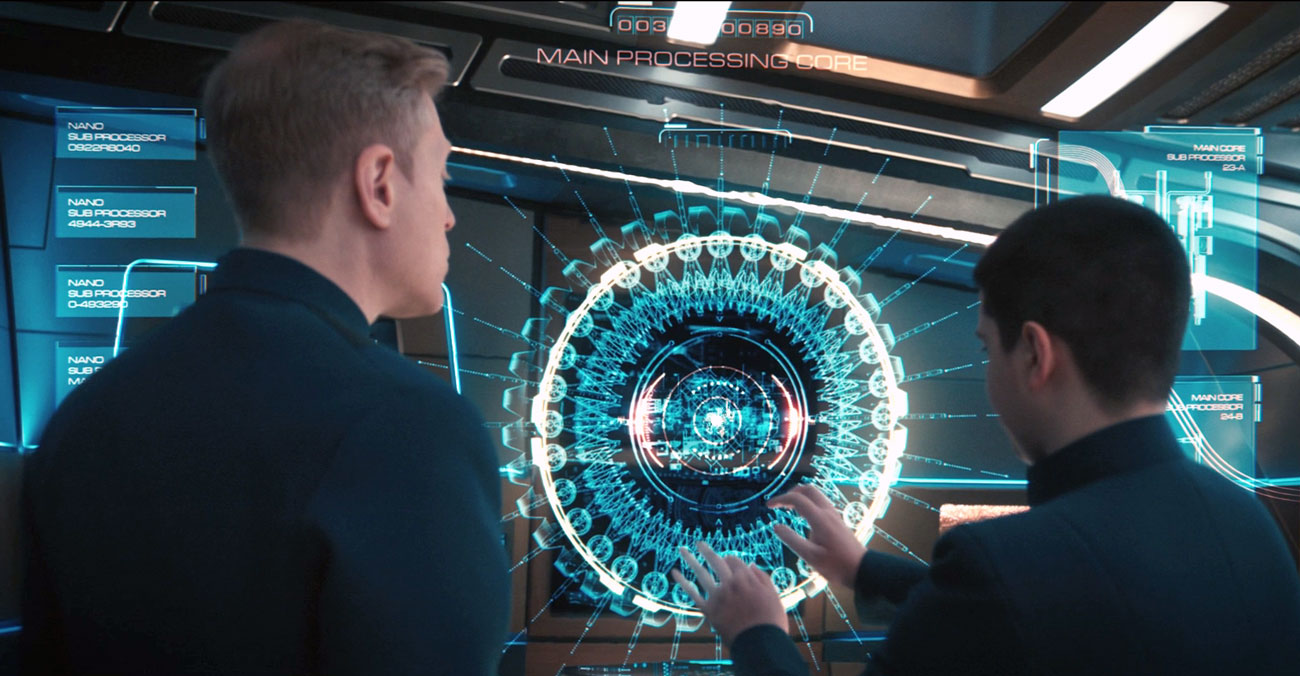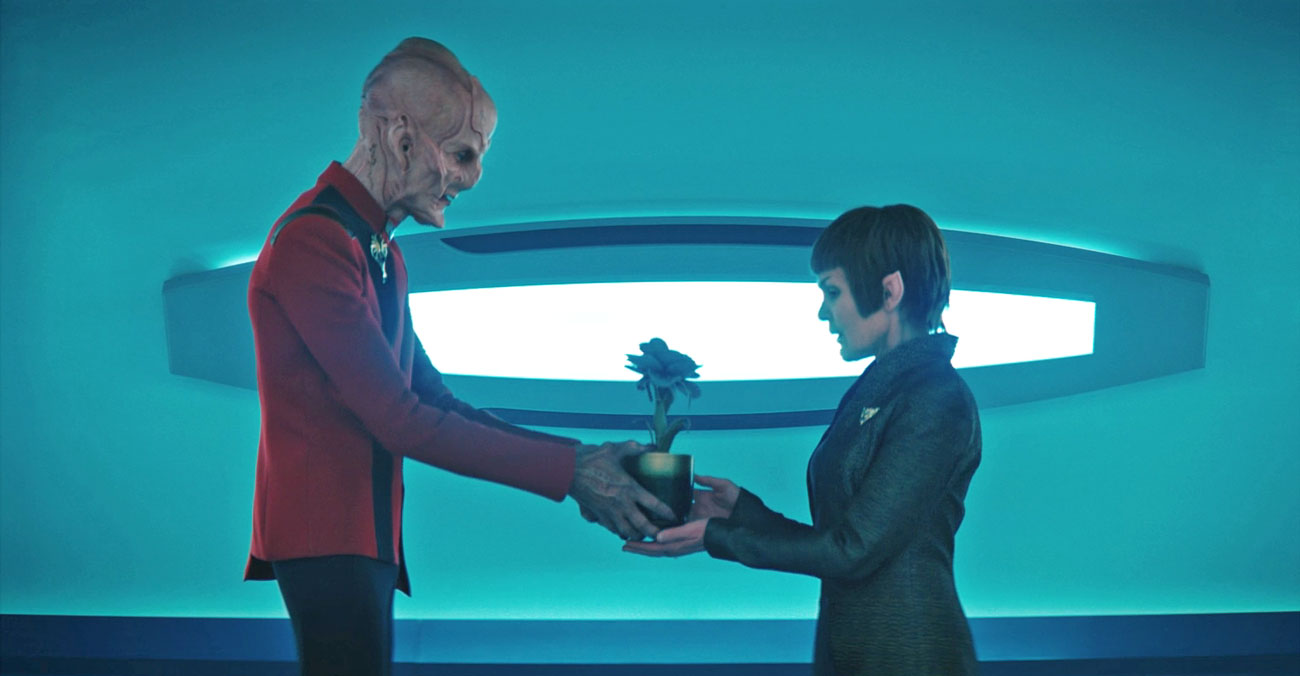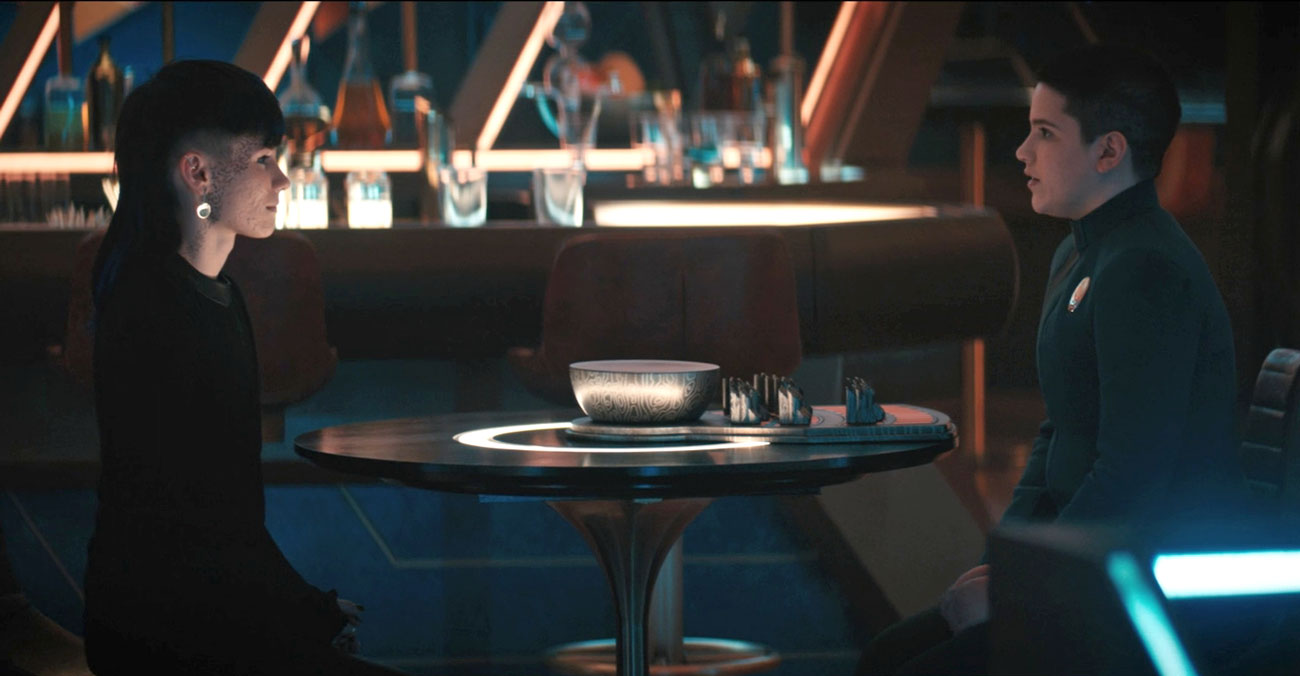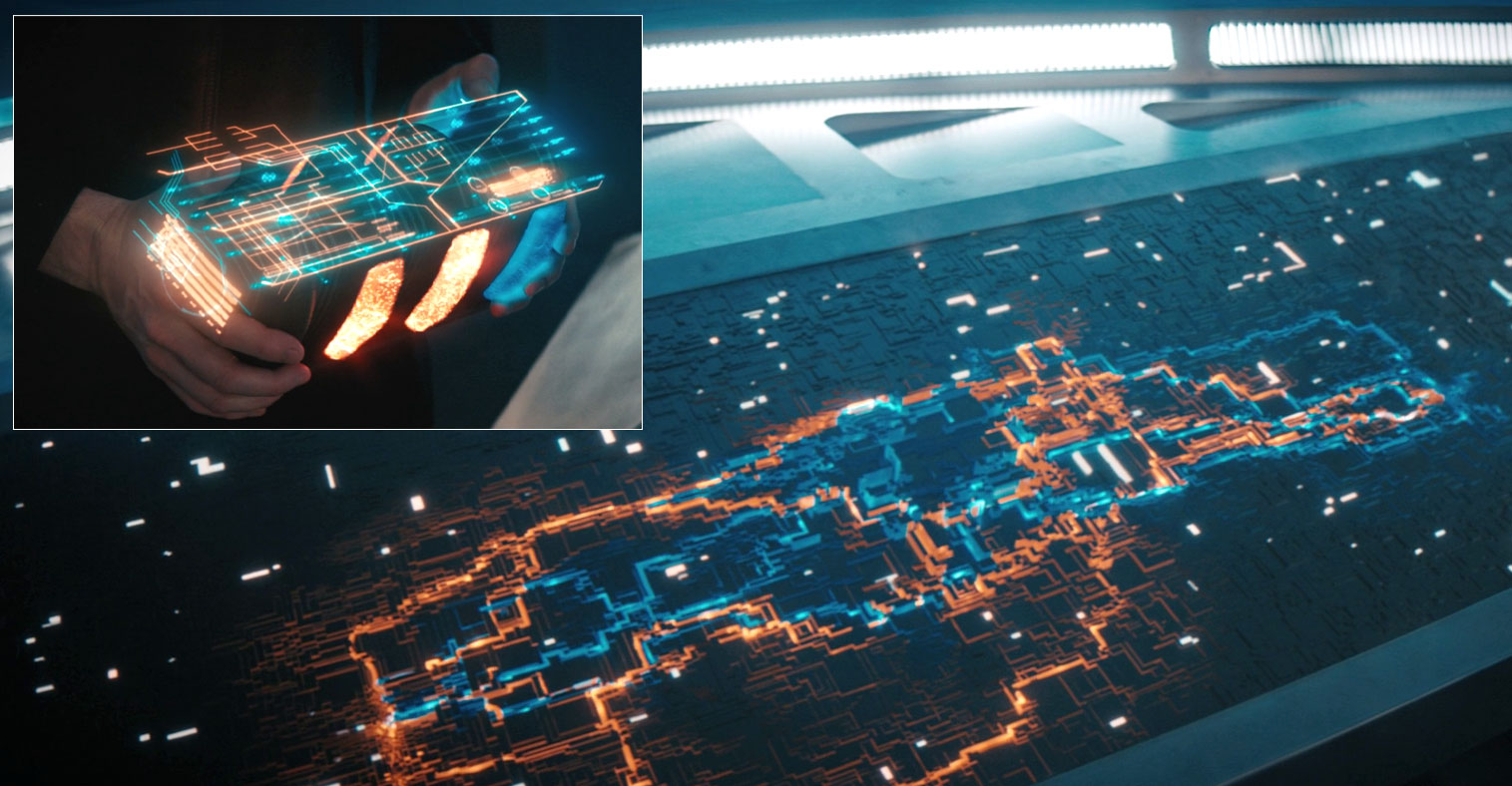Star Trek: Discovery wraps up the first half of Season 4 with “…But To Connect,” telling intertwining stories of existing connections strengthening, old connections falling away, and new connections being forged, and of the emotional landscape that underpins each of these circumstances.
As Discovery prepares to attend the “Multilateral DMA Strategy Assembly” — a galaxy-wide conference in which Federation and non-Federation alike will have a say in how to proceed about the dark matter anomaly — Stamets (Anthony Rapp) and Adira (Blu del Barrio) work with Zora to finish the calculations necessary to pinpoint the DMA’s point of origin, based upon its potential path through the galactic barrier.
The calculations are taking longer than expected, and Stamets’ frustrations over Zora’s (Annabelle Wallace) new emotional consciousness are borne out when, at the last moment, Zora announces that she knows the coordinates… but is choosing to keep them to herself, even defying a direct order from Discovery’s captain.
This is a big problem, of course, but not one Captain Burnham (Sonequa Martin-Green) has time to focus on as she and Book (David Ajala) must make their way to the conference, filled with familiar 32nd century aliens and faces, including T’Rina (Tara Rosling) of Ni’Var and Ndoye (Phumzile Sitole) of Earth, introduced last season.
Realistically I have to assume the assembly is actually much more involved than we see — or at the very least, that all the participants had a big stack of pre-reading to do beforehand — but the way it’s depicted, it appears that President Rillak (Chela Horsdal) just jumps right to the core of the matter: what is to be done about the DMA?
While she outlines a diplomatic strategy involving peaceful contact with the extragalactic Species 10-C — speaking for Starfleet, Burnham emphasizes that destruction doesn’t necessary equate with malicious intent, as with swarms of insects devouring crops — many of the people in attendance grumble. Ruan Tarka (Shawn Doyle), watching from the audience, sees an opening to interrupt the proceedings to announce that he’s developed a way to disable the DMA.
It’s a tantalizing prospect, until we learn that Tarka’s device is an isolytic weapon, which fans of Star Trek: Insurrection already know is a science banned by the Second Khitomer Accords, as it can potentially ‘poison’ subspace and render warp drive impossible across a wide swath of space. A 32nd century dirty bomb — unquestionably effective, but also unquestionably unethical.
The debate begins to heat up, with the still-suffering Book advocating for Tarka’s plan to stop the DMA — even if it may pose a technobabbly risk to Species 10-C in the process — Rillak calls for a recess, which opens the door for us to learn more about the sly scientist. As he speaks with Book, we find out why Tarka is so keen on disabling the DMA instead of outright destroying it: he needs anomaly’s the immense power source to create a portal to a parallel universe!
Immediately shutting down talk of the Mirror Universe, Tarka has set his sights on a another peaceful plane of existence: a dimension where the Burn never happened, the Emerald Chain never formed, and where he believes a fellow scientist and friend — who he worked with during his time in Chain captivity — may be waiting for him. (His plight is moving, and while it might be too much to ask I hope there’s a way for both plans to succeed: peaceful first contact with Species 10-C, and a way for Tarka to reunite with his friend in that idyllic alternate universe.)
When the assembly reconvenes, Book speaks again, urging the group to vote in favor of using Tarka’s weapon to prevent the DMA from taking any more lives. It’s an impassioned speech, and one pointedly directed at Burnham (as much as to anyone else in the room).
When Burnham argues in favor of diplomacy, the invisible tether that has held Book and Burnham together over the last season and a half snaps: though she was clearly reluctant to do so, from Book’s perspective, she chose Starfleet over his needs, just as the shade of his father had predicted in last week’s episode — and the assembly’s vote to pursue a diplomatic approach to Species 10-C underscores Book’s frustration.
Meanwhile back aboard Discovery, Stamets has been grappling with the fact that no one else seems to be nearly as alarmed as he is about the danger posed by Zora’s free will and emotional complexity. In fact, the trio of Saru (Doug Jones), Culber (Wilson Cruz), and Kovich (David Cronenberg) are so calm about as to seem frankly dismissive of Stamets’ perfectly reasonable concerns, chalking his worry up to trauma instead of acknowledging the objective fact that as the ship itself, Zora could easily kill or subdue the crew in about a hundred different ways before anyone could stop her.
In an attempt to alleviate Stamets’ concerns, Zora creates a failsafe device that can be used to immediately and irreversibly terminate her higher consciousness — if at any point the crew feels endangered by her. Setting aside the potential problems with trusting a failsafe created by the very thing it’s supposed to kill, the extremity of the “solution” feels manipulative to me. When the disciplinary options are to either do nothing and let someone do whatever they want or kill them, do you really have an option?
This isn’t the Terran Empire, and Starfleet captains don’t summarily execute subordinates who refuse an order. The fact that no one argues for a less draconian solution seems like an instance of “seeing” the writing. If any of the characters had brought up this reasonable and expected alternative to the failsafe, it would have rendered the rest of the story — which was clearly important to the writers to tell — moot, wrapping this whole thing up in about five minutes.
Before long, both Adira and Gray (Ian Alexander) interrupt the proceedings because they both want to advocate on Zora’s behalf. For about 0.68 seconds, I rolled my eyes at the way they just barged into the discussion before reminding myself that this is established “precocious ensign” behavior in the Star Trek universe. (Wesley Crusher did this very thing at least ten times and usually saved the day as a result; Tilly has done it more than onec, too. It’s fine.)
With Adira’s help, Kovich and Stamets discover a fragment of unknown and seemingly spontaneously generated code in Zora’s programming, which the trio quickly determine that it is, in essence, Zora’s subconscious. It’s full of imagery of Discovery’s crew in moments of love, support, caring, and kindness and is the source of Zora’s assertion that her primary function is to care for the crew. (This is, of course, not the Discovery computer’s programmed primary function, which Zora has now transcended.)
After some additional examination, Kovich determines that Zora is, on her most fundamental level, good — and it’s because of this goodness that she refuses to give up the location of the DMA’s origin; she fears for the crew and sees preventing the encounter with Species 10-C as an act of care and protection.
But it’s also because of her goodness that she eventually understands and accepts that part of caring for someone is trusting them. Zora provides the coordinates and all is well. If this were a real life situation, I would need more than just a cursory glance at a few lines of code and a browse through a private camera roll to be convinced — but I’m willing to accept the conclusion within the context of the show.
It’s clear that the episode isn’t teasing any lingering doubts or suspicions, especially when Zora is offered (and enthusiastically accepts) a commission into Starfleet. This brings Zora into the crew, hopefully resolving any chain of command issues that might remain — she might be a new kind of lifeform with agency, but Zora still needs to obey her captain.
That said, the episode seems to think that the only hurdles the crew will need to get over are those of trust and safety. While those are certainly critical, from my perspective they left one out: the massive social and emotional implications of Zora’s presence. To put it simply, now that Zora exists a person can never really be alone aboard Discovery.
This isn’t just about surveillance — though, that’s a thorny issue too — it’s about solitude, or the lack thereof. For some people this might be a comforting thought, the notion that the place you call home loves and cares for you and is always there. For me, though, this has the potential to quickly become stifling. For people like me who need some amount of ‘alone time’ in their lives, having a constant, unseen, and unavoidable companion is a recipe for stress and anxiety.
Imagine never truly feeling able to relax and be yourself because someone else is always around.
Compare this with Gomtuu, the telepathic living ship from “Tin Man” who comes to a symbiotic arrangement with the also-telepathic Tam Elbrun. They bond immediately, each freely communicating their needs, thoughts, and feelings with the other and each benefitting equally from their communion. While it’s true that Tam will also never again be physically alone, because he can sense Gomtuu as well as Gomtuu can him there’s a way for him to ask Gomtuu to give him distance — and to know his request is being granted.
Meanwhile, Zora is all-seeing but unseeable, a one-way mirror to Gomtuu’s window. If Zora is going to be a social and emotional presence in everyone’s life, some kind of solution that allows the crew to see and evaluate her mood — just as she sees and evaluates theirs — is absolutely necessary. Without one, emotional communication is only going to flow one way, putting the crew at an automatic social disadvantage.
Put another way: in her current state, Zora doesn’t have body language or non-verbal social cues for the crew to read and respond to, while we know that she picks up on and reads the crew’s. Anyone who has trouble reading the people around them in real life knows how easy miscommunication can be, and having to worry about accidentally offending my kitchen — or giving the car some extra attention when it’s feeling depressed — seems like an absolute nightmare.
I do want to emphasize that none of this is a criticism of the show or the writing; I do not expect Star Trek or any other work of fiction to be crafted with my own specific neuroses in mind. That said, I simply could not set aside my growing discomfort with Zora as an omnipresent and unreadable roommate, and it affected how I engaged with the storyline.
While I wish Zora nothing but the best, this is a big enough issue for me that if I were stationed aboard Discover… for my own wellbeing, I would immediately need to put in for a transfer. (Maybe Tilly could use a pal back at Starfleet Academy?)
OBSERVATION LOUNGE
- The budding connection between Saru and T’Rina seems to be moving towards bloom, as he brings Ni’Var’s president a Kelpien plant as thanks for her gift of salt tea back in “All Is Possible.” T’Rina is positively trembling with emotion — such as a reserved Vulcan can, at least — and whatever form their relationship takes, their chemistry is clear. Their moments together make me so happy… I ship them so hard, you guys!
- We learn from a bit of pre-meeting chitchat with United Earth’s General Ndoye that humanity’s home planet still hasn’t rejoined the Federation, but they are moving in a less isolationist direction with the entry of Titan into the UE family. (Baby steps!)
- We only see the Ferengi delegate briefly, but from what we do see it’s clear the art of eccentrically-tailored brocade suits remains alive and well on Ferenginar. It’s very easy to imagine Quark or a Grand Nagus of the 24th century wearing the 32nd century delegate’s suit.
- Meanwhile, the Orion delegate looks ready to hit the club. Just gotta submit a quick vote on the fate of the galaxy, then it’s a night out with the girls — no big deal! Next to her, someone I believe to be her male counterpart (there appear to be some matching elements on both their costumes) wears what I can only describe as a full-face dandelion shroud. Ah, Orion; you truly are the Met Gala of the galaxy.
- Another relationship is going to be tested — but hopefully strengthened — as Gray announces his decision to return to Trill to continue his studies toward becoming a guardian, as he and Adira agree to try and keep things going over holo-Facetime. The ensign will be back to Discovery after a weeklong sojurn on Trill, but it’s unclear how much we’ll see of Gray the rest of this season.
After all the build-up over getting him out of Adira’s mind and back into a body of his own, it’s a bit surprising to see the Trill shipped off so soon… but as he rightfully pointed out last week, it’s not like he can just spend all day hanging around in the lounge.
- The coordinates of the DMA’s origin are 07-89732.33299-99 + 98655, the format of which doesn’t correspond to any standard cosmological coordinate system (as far as I’m aware), or to the way galactic coordinates and starship headings are typically stated in Star Trek. I think this one is just technobabble, folks.
- Now that Zora’s been commissioned into Starfleet, will she have to take the Kobayashi Maru training scenario? (Free story idea, Discovery writers!)
- The new spore drive is a plug-and-play device, thanks to programmable matter, easily carried around by a single person — though it still can’t be piloted by anyone besides Stamets (who has that special tardigrade DNA infusion) or Book (the last known Kwejian).
Even with the DMA’s source coordinates now known — and with the assembly’s vote to attempt peaceful contact with Species 10-C — it’s unclear how exactly that might be accomplished. Can the spore drive make jumps to places outside the galaxy? Does the mycelial network extend through all of space?
But before Discovery can work out the logistics, a new problem arises. Tarka has stolen the next generation spore drive, and we head into the midseason break as he and Book jump away from Discovery in an effort to deploy the scientists’ DMA-killing weapon.
It seems it’s going to fall to Burnham and the rest of the Discovery crew to stop them, and that peaceful first contact — and answers to the 10-C mystery — are going to have to wait.
![]()
Star Trek: Discovery Season 4 heads into a six week hiatus, as Star Trek: Prodigy returns next Thursday, January 6, with “Kobayashi.”
The series will return on February 10 Paramount+ in the United States, and on CTV Sci Fi Channel and Crave in Canada. Outside of North America, the series is available on Paramount+ and on Pluto TV in select international locations.


